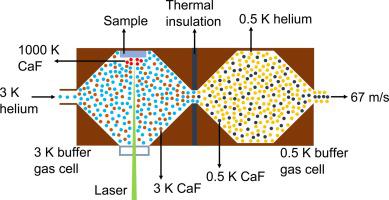Cryogenics ( IF 1.8 ) Pub Date : 2021-07-24 , DOI: 10.1016/j.cryogenics.2021.103335 Vijay Singh 1

|
A novel two-stage helium buffer gas cooled beam source is introduced. The properties of the molecular beams produced from this source are investigated theoretically using the CaF as a test molecule. The gas-phase molecules are first produced inside a 3 K helium buffer gas cell by laser ablation and subsequently cooled down to 3 K by collisions with buffer gas atoms. The precooled molecules are then extracted into the 0.5 K helium buffer gas cell where they are cooled further down to 0.5 K by collisions with cold helium atoms. Finally, the cold molecules are extracted out into the high vacuum through the 0.5 K cell exit aperture and form a molecular beam. The mean forward velocity and extraction efficiency of the molecules from the buffer gas cells into the molecular beam are calculated to be 67 m/s and 16 respectively when both buffer gas cells are operated in hydrodynamic entrainment regime. Benefitted from this high extraction efficiency as well as the increased number of slower molecules resulting from the low operating temperature of the second stage cell, this source will enable efficient magneto-optical trapping of the molecules, investigations of sympathetic cooling of the molecules with ultracold atoms, and performing ultrahigh precision molecular spectroscopy.
中文翻译:

两级缓冲气冷光束源的理论研究
介绍了一种新型的两级氦气缓冲气冷束源。使用 CaF 作为测试分子,从理论上研究了从该源产生的分子束的特性。气相分子首先通过激光烧蚀在 3 K 氦缓冲气室中产生,随后通过与缓冲气体原子碰撞冷却至 3 K。然后将预冷的分子提取到 0.5 K 氦缓冲气室中,在那里它们通过与冷氦原子碰撞而进一步冷却至 0.5 K。最后,冷分子通过 0.5 K 电池出口孔被提取到高真空中并形成分子束。分子从缓冲气室进入分子束的平均前进速度和提取效率计算为 67 m/s 和 16分别是当两个缓冲气体池都在流体动力夹带方式下运行时。受益于这种高提取效率以及由于第二阶段电池的低工作温度导致慢分子数量的增加,该来源将能够有效地对分子进行磁光捕获,研究具有超冷原子的分子的交感冷却,并进行超高精度分子光谱。











































 京公网安备 11010802027423号
京公网安备 11010802027423号